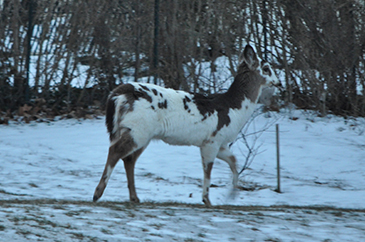Animal Control
Western Monmouth Animal Control is a regional animal control service administered by the Manalapan Township Department of Health. Animal Control responds to domestic animal complaints, problems and issues. The first priority of the animal control’s duties is to help injured or sick animals. All other calls regarding animals follow in priority. For services or information please call 732- 446-8345.
Stray Animals
If you see a stray dog or cat, please report it by calling the Animal Control Officer via the Health Department at 732-446-8345 during normal hours. After working hours, please call the police. Stray dogs and cats are transported to SPCA in Eatontown (732-542-0040). If you lost an animal, please call Animal Control or the Shelter. If you encounter an injured dog or cat, please call the Animal Control Officer via the Health Department at 732-446-8345. If you encounter an injured wild animal, contact an licensed wildlife rehabilitator. The list of animal rehabilitators in NJ can be found on NJ Division of Fish, Game & Wildlife website – http://www.state.nj.us/dep/fgw/pdf/rehab_list.pdf.
Animal Bites
All bites by animals, whether by domestic or wild animal are reported to the Health Department and Animal Control. Public Health Officials and Animal Control Officers work collaboratively to verify that the biting animal does not have rabies. In absence of this information, the officials will assist in the determination of whether post-exposure vaccinations are warranted to protect against the possibility of rabies.
Recognizing Rabies
Rabies is a very serious threat to human health. With rare exception once an exposure to the disease progresses to active symptoms it almost always results in death. Thus, working early in the timeframe following a possible exposure to determine if medical intervention is warranted is critical. An animal may be infected with rabies for a long time before it shows symptoms, anywhere from two weeks to many months. (The incubation period is usually two to three weeks.). If the biting animal is available to observe for illness no medical intervention is probably warranted. However, when the biting animal is not available, public health officials and animal control officers will work together to provide the best and most appropriate post-bite recommendations.
Here are some of the symptoms of rabies to be aware of when observing animals:
- Unprovoked aggression (“furious” rabies). Some animals may attack anything that moves, or even inanimate objects.
- Unusual friendliness (“dumb” rabies).
- Animal may stumble, fall, appear disoriented or uncoordinated, or wander aimlessly.
- Paralysis, often beginning in the hind legs or throat. Paralysis of the throat muscles can cause the animal to bark, whine, drool, choke, or froth at the mouth.
- Vocalizations ranging from chattering to shrill scream.
- Nocturnal animals may become unusually active during the day (remember, some daytime activity is normal, especially when nocturnal animals are feeding their young).
Rabies Vaccination Clinics
Family pets require love and regular care. The Township sponsors an annual free rabies vaccination clinic for dogs and cats. The clinic is generally held on the first Saturday of November. Please call the Health Department to confirm this date and to get its location and times.
Wild Animals and Residential Wildlife Control
Click here to know what to consider before setting your own humane trap
There are many species of wild animals in our community. Wild animals are generally well accepted and a large part of what makes the community attractive and desirable. The Township of Manalapan does not provide services to remove healthy residential wildlife. As a precaution, never leave food outside your house. Otherwise, it will attract various wildlife to your doorstep. If interested or needing to remove nuisance wildlife please contact a residential wildlife control company to assist you with problems. There are many private contractors that provide these services. Names of contractors are available by searching the internet for Wildlife Control in Monmouth County, NJ. However, if the wild animal is acting unusual, injured, or sick, please contact the Animal Control Officer immediately at 732-446-8345.
Feral Cats and their colonies
Animal Control receives many calls of cat colonies in residential areas of Manalapan. In New Jersey, cats are the third highest species of animal to become infected with rabies. Many of the stray cats in residential neighborhoods are not vaccinated against rabies and risk encounter with wild raccoons at night which can have rabies. Therefore, the Township discourages residents from feeding feral cats due to this potential risk of rabies and a higher likelihood that a rabid cat can expose humans to the disease as opposed to a wild animal.
Bats
Bats play a major role in our ecosystem. However, bats are associated with several diseases that can cause harm to humans. Rabies is perhaps the most well known disease associated with bats. Along with animals such as foxes, raccoons, and skunks, bats are one of the primary animals that transmit rabies. Some bats live in buildings, and may continue to do so with little risk to inhabitants if they are unable to access living areas and the potential for contact with people is low. However, bats should always be prevented from entering rooms of your home. The first strategy to preventing bats entering your home is to “bat proof” your home or living quarters to prevent bats from using your home for a roosting site. For best results, contact an animal control officer or wildlife conservation agency and ask for assistance.
Here are some “bat proofing” techniques:
- Carefully examine your home for holes that might allow bats entry into your living quarters.
- Any openings larger than a quarter-inch by a half-inch should be caulked.
- Fill electrical and plumbing holes with stainless steel wool or caulking. Ensure that all doors to the outside close tightly.
- Most bats leave in the fall or winter to hibernate, so these are the best times to “bat-proof” your home. During summer, many young bats are unable to fly. If you exclude adult bats during this time, the young may be trapped inside.
If a bat is in your home, please contact Animal Control for assistance in capturing the bat. Animal Control Officers are available during the day by calling the Health Department and in the evening and weekends by calling the Police Department. Residents are discouraged from letting the animal fly free from the home if there is any chance the animal could have been in the residence overnight or any time residents could have been sleeping. Capturing the bat is important for rabies testing.
Fox
The most common foxes found in New Jersey are the Red Fox and the Gray Fox. These animals cause problems for people since they prey on small animals such as chipmunks, field mice and moles and even domestic animals like cats. They have the potential to carry disease including rabies. Foxes are attracted onto residential properties due to the well maintained lawns which can be a possible habitat for them to live in and find prey. Foxes are not generally aggressive towards humans. People becoming uncomfortable with fox sightings should remove attractions, put up fences, and perform scaring techniques. If you’re concerned about a possible fox nuisance, please call a residential wildlife control company to evaluate the best way to remove the animal.
Rats
The most common species of rats in the United States are the Norway Rat and Roof Rat. Rats can be a nuisance in many people’s homes due to their habits of living in the house and gnawing. Here are some tips for rat control. Inspection is very important, since it allows you to find the location of the rats, so you can set traps and bait. Exclusion is used to stop rats from entering your house. Small openings in walls should be sealed so that rats cannot enter the house. Trapping or baiting are often used to stop rat populations.
Trapping does have some advantages over baiting. It provides an alternative for those who do not want to place rodenticides. If the rat population is small enough, trapping can yield quick results when done properly. Finally, trapping ensures that you can dispose of the dead rats before their odor becomes a problem in an inaccessible area.
Rodenticides are poison baits and should be used in areas where domestic animals and children can’t access them. For protection against accidental poisoning, use tamper-resistant bait stations that hold the baits in place and keep children and pets out. It is a national law and guideline to use tamper-resistant bait stations in areas where children or pets can access.
Coyotes
If a coyote is seen on your property or any other wildlife, just monitor the situation. If the wildlife is just passing through without showing signs of injury or aggression (possible rabid) then there is no need to call the Animal Control Department. We can only handle sick or injured wildlife within Manalapan Township
Link for more info: http://www.state.nj.us/dep/fgw/coyote_info.htm
Bears
The most common bear problem New Jersey’s residents experience is black bears getting into their garbage. Bears are attracted to neighborhoods by garbage odors, so properly securing your garbage is one of the best ways to prevent bears from becoming a nuisance in your community.
Residents are encouraged to work within their community to make sure all garbage is secured and kept away from bears. For tips on proper garbage management and coexisting with bears, visit: www.njfishandwildlife.com/bearfacts_avoid.htm
Black bears by nature tend to be wary of people. However, if you encounter a black bear in your neighborhood or outdoors while hiking or camping, follow these common-sense safety tips.
- Never feed or approach a bear!
- Remain calm if you encounter a bear.
- Make the bear aware of your presence by speaking in an assertive voice, singing, clapping your hands, or making other noises.
- Make sure the bear has an escape route.
- If a bear enters your home, provide it with an escape route by propping all doors open.
- Avoid direct eye contact, which may be perceived by a bear as a challenge. Never run from a bear. Instead, slowly back away.
- To scare the bear away, make loud noises by yelling, banging pots and pans or using an air horn. Make yourself look as big as possible by waving your arms. If you are with someone else, stand close together with your arms raised above your head.
- The bear may utter a series of huffs, make popping jaw sounds by snapping its jaws and swat the ground. These are warning signs that you are too close. Slowly back away, avoid direct eye contact and do not run.
- If a bear stands on its hind legs or moves closer, it may be trying to get a better view or detect scents in the air. It is usually not a threatening behavior.
- Black bears will sometimes “bluff charge” when cornered, threatened or attempting to steal food. Stand your ground, avoid direct eye contact, then slowly back away and do not run.
- If the bear does not leave, move to a secure area.
- Report black bear damage or nuisance behavior to the DEP’s 24-hour, toll-free hotline at 1-877-WARN DEP (1-877-927-6337).
- Families who live in areas frequented by black bears should have a “Bear Plan” in place for children, with an escape route and planned use of whistles and air horns.
- Black bear attacks are extremely rare. If a black bear does attack, fight back!
Adopting a Dog or Cat- General Guidelines
Adopting a dog can bring joy and love to your family. Here are some guidelines in adopting a dog:
Things to buy before and after adoption: Food, bowls for water and food, a leash, collar, and bedding. What works best are baby blankets, or thin blankets which can fit in the washing machine. Often cast-off, bulky comforters can be cut into quarters. Consider purchasing an ID tag. Many pet stores have machines where you can create an ID tag immediately. Some rescues and shelters also provide an ID tag. Make sure to get your dog licensed at the Manalapan Health Department – which is another good form of ID!
Your dog’s period of adjustment: The first couple of weeks you and your pet are “getting to know one another”. They don’t know why they have come to your home nor what is expected of them. Please be patient with your dog and anticipate problems before they occur. Don’t leave tempting shoes, clothing, or children’s toys within reach of your dog.
Watch for you dog’s symptoms: When your dog is settling in, they may experience shyness, anxiety, restlessness, excitement, crying or barking. They may exhibit excessive water drinking, frequent urination, or diarrhea. Their appetite may not be good. If any of these symptoms last more than a few days, call your veterinarian.
Be Patient: Your new dog must learn a whole set of new rules. Be patient and be consistent. Don’t allow them to do something one time and forbid it another.
Obedience training: A six to eight week class taking one hour of your time one day a week, and a training lesson with your dog 1/2 hour a day, will teach your dog the simple obedience commands so necessary in having a well-behaved pet. Just as we must teach our children manners, we must also teach our pet. Local training providers are available by searching the internet.
FOLLOW THESE GUIDELINES FOR AT LEAST THE FIRST TWO WEEKS WITH YOUR NEW ANIMAL. PLEASE REMEMBER, IT TAKES PATIENCE TO TRAIN YOUR NEW ANIMAL!
- DO immediately show your dog to his/her appropriate toilet area.
- DO take your dog to the designated toilet area once an hour, every hour, on leash (except overnight). Allow supervised free time only after he relieves himself in the appropriate area. If your dog does not go to the bathroom on one of these trips, confine him to his “doggie den” OR keep him on leash and supervised, until the next scheduled potty break.
- DO confine your dog to a “doggie den” whenever you are physically (or mentally!) absent. Such as when you are at work, paying bills, making dinner, sleeping, etc. -DO throw away your dog food bowl! Instead, feed your dog out of a hollow Kong or other chew toy stuffed with kibble and snacks throughout the day, especially when she in her “doggie den” or when you are busy. Also use part of your dog’s daily ration while on walks, during training or when meeting new people.
- DO provide plenty of appropriate chew toys to keep your dog busy and prevent chewing “casualties” in your home and yard. Redirect any chewing “mistakes” by directing your dog to an acceptable alternative. This will also help establish an appropriate chewing habit for the lifetime of your dog.
- DO introduce your dog to new people and other pets gradually so as not to overwhelm him. Use kibble and treats to help form a positive association to new people. Be sure he has access to his “den” in case he needs a break from all the activity.
- DO enroll in a basic obedience class right away! This will help you to understand how to better communicate with your dog in a way she will understand.
- DON’T allow your dog free run of the entire house right away, or else your new friend may learn all sorts of bad habits. First take the time to teach him good habits.
Got a New Cat?
- Make Sure Everyone In The House Is Prepared To Have A Cat: Talk to your family members before bringing a new cat home. Make sure everyone knows that the fun begins only after kitty feels safe and her needs are met. Once you’re sure everyone is ready for feeding, litter changing and grooming, you can divvy up chores among family members so everyone is prepared to care for kitty before she arrives.
- Do You Know What Your Cat Is Trying To Tell You?: The average cat has a vocabulary of more than 16 different sounds, including purring, howling, hissing and meowing—not to mention a wide-range of playful and serious body language.
Stock Up On Supplies Before your Cat Arrives: Have all of your cat’s needs ready so they can get right down to the business of making herself at home. Your cat will need:
- A litter box and the brand of litter
- Food and water bowls and the food
- A sturdy, rough-textured scratching post—at least three feet high—that allows them to stretch completely while scratching
- Safe, stimulating toys. Hint: If you give them toys that make noises, you’ll know when they’re playing.
- A bed lined with a soft, warm blanket or towel
- Grooming tools: a high-quality brush and nail clipper are a good start
- Identity Is Key: Proper identification is a necessity. If your cat is indoors-only, an ID tag or implanted microchip will help ensure she’ll be returned to you if she gets out and can’t find her way home. A safety collar with an elastic panel will allow your cat to break loose if the collar gets caught on something. We caution against letting cats outdoors, but if you do—or if a window or door is left open—a safety collar and an ID tag may be what bring your missing cat home.
- Routine Behavior: Give your cat a little structure to lean on. For the first few weeks, provide him with the same kind of food and feeding schedule he had before living with you—and give him the same brand of litter, too, for a familiar scent and feel on his paws. Later on, if you wish to switch to different products, you can make a slow transition.
- Introducing the Cat in the environment: Go slow at first. A cat may need seven to fourteen days to relax into her new environment. If you have kids, let them introduce themselves one at a time. Hold up on the meet-and-greets with friends, neighbors and relatives until your kitty is eating and eliminating on a normal schedule. If you have other pets, don’t let your new addition have free run of the house. This is the territory of the animals that have lived with you already. Allow all of your pets to meet in the new cat’s territory—and make sure you’re there to supervise.
- Visit the Vet for the first week!
Here are important summer tips for pet care:
Never leave pets in the hot car: It can take MINUTES before a pet can develop heat stroke, and suffocate. It is best advised to leave pets at home during the hot day. If not, bring water and a water dish and take your pet with you.
Make sure your pet is protected: Make regular visits to the vet and have protection against parasites. Parasites include ticks, fleas, and mosquitoes. Otherwise, your dog can have a risk of heartworm.
Watch for the paws: During hot weathers, the surfaces like asphalt or metal can get really hot! Try to keep your pet off of hot asphalt; not only can it burn paws, but it can also increase body temperature and lead to overheating.
Must have access to water: Pets get much thirstier than humans do, when they get hot, and other than panting and drinking, they really have no way to cool themselves down. Also, provide your pet shade as often as possible.
Pets don’t always know how to swim: Dogs and cats may not always know how to swim. It is always advised to keep pets away from swimming pools.
Pets can easily get sunburn: Pets can also get sunburn and it can be as painful. Always watch out for prolonged exposure in the sun.
Always leash: If you can’t trust your pet without a leash, it is always advised to keep them on it. Usually, a unleashed pet may get lost or attacked by other animals. When in doubt, keep your pets on a leash.\
Backyard Chickens
Chickens are becoming more popular in the Manalapan Township, since there are no zoning restrictions. Backyard chickens are low maintenance animals, and only require a coop to live in. Here are some reasons why homeowners own chickens:
- Great tasting nutritious eggs
- A Healthy lawn: Chickens LOVE to range freely, and allowing them to do so kills the proverbial two birds with one stone: they’ll eat any garden pest they can get their beaks on (earwigs, grubs, beetles, even moles) and they’ll turn that into fertilizer. Chickens will even cut down on the amount of mowing because they love to eat grass.
- Low Maintenance: Chickens don’t need to be walked, brushed, or fed twice a day. Essentially all you have to do is gather eggs daily, fill their food and water containers a couple of times a week and change their bedding once a month!
Are they right for you?
- Can You Dedicate Some Time Each Day?
Although low-maintenance, chickens do require a small amount of daily care as well as some monthly and semi-annual maintenance. Plan on spending 10 minutes a day on your pet chickens, an hour or so per month, plus a few hours twice a year on semi-annual chores. If that sounds like too much, then chickens aren’t right for you. - Do You Have Enough Space?
Chickens don’t require a ton of space. If they’ll be “cooped up” with no area outside to freely roam, your coop will need to provide a minimum of 10 square feet per bird. On the other hand, if they’ll have an outdoor “run” area or will be allowed to range freely, which is preferable, they only require two to four square feet per bird inside the coop, as long as they also have at least 10 square feet per bird in the outside run. That said, the more space the better, both indoors and out! Chickens are great foragers, eating insects, grasses and weeds, and many other tidbits they find in the yard. The more foraging they do, the healthier – and happier – they will be. Also keep in mind that the less outdoor space they have, the more they will destroy the area they do have. Chickens obsessively scratch up the soil, peck at what they find, and scratch some more. They also dig holes for “dust baths”. And they REALLY love to eat plants and weeds. Consequently, if their run area is small, they’ll make a dustbowl out of it in a week. On the other hand, give them a large run area – or better yet let them range freely, and your yard will benefit immensely. Their scratching behavior aerates the soil; their droppings fertilize it; and they’ll eat pests such as grubs and ticks.
Considering Your Neighbors
- If nothing so far has given you pause, you still need to consider your neighbors, especially if they’re close by. They may not be educated about chicken-keeping and so could have concerns ranging from noise, or smell. It might be a good idea for you to check in with them early on and address any concerns. Often there are many complaints for male chickens known as roosters which are known to cause noise. Please be considerate when owning a rooster. Many other people wouldn’t want to be annoyed by crowing of the rooster. Other nuisance complaints usually are free ranged chicken exploring their neighbor’s property, and leaving feces. Please be considerate with your neighbors.
Chicken Coop requirements cite from (mypetchicken.com)
An adequate chicken coop design must:
- Be predator-proof, not just from the sides, but from above and below as well. Predators that would love chicken wings for dinner include but are not limited to raccoons, foxes, wolves, coyotes and hawks. (Tip from a fellow chicken owner: be sure to select the right wire mesh. The holes in standard “chicken wire” are actually quite large. Yes, it will keep the chickens in, but raccoons can reach through those holes and do some nasty things… Not a pretty sight. We recommend one-half inch square “hardware cloth”.)
- Be secure from nasty rodents (yes, rats!) that will be attracted to the feed and droppings. Rodents are burrowing creatures, so you need to block them from slipping into the coop from below. If you coop doesn’t have a floor, you need to bury small-mesh fencing down into the ground about 12″ all around the coop.
- Be breezy enough to prevent respiratory diseases, to which chickens are especially prone, but not so drafty during winter that they freeze. Chickens can withstand the cold so long as it’s not drafty!
- Be easy to clean so bugs and bacteria don’t fester
- Provide “roosting poles” for your girls to sleep on (2″ wide; rounded edges; allot 5-10″ of space per bird side to side and 10″ between poles if more than one is necessary; plus ladder-like grading so the pole furthest away is several inches higher than the closest).
- Encourage egg-laying with 1 nest box for every four or five chickens. Nest boxes should be raised off the ground at least a few inches, but lower than the lowest roosting pole. They should also be dark and “out of the way” to cater to the hen’s
- Be roomy: at least 4 square feet per bird if birds are able to roam freely during the day, and at least 10 square feet per bird if they are permanently confined.
- Accommodate a feeder and water, which should hang 6-8″ off the ground.
- Include a removable “droppings tray” under roosting poles for capture and easy disposal of droppings. (Or should we say for easy access to your lawn fertilizer?)
- Similar to the coop, the sides of the attached chicken run, if you have one, should be buried 12″ into the soil to keep predators and rodents from digging their way in. Once again, we recommend chicken wire fencing or half-inch hardware cloth. It’s also our strong recommendation that you secure the top of the run with aviary netting or deer netting. This will keep wild birds (which can carry communicable diseases) out and provide further defense against sly predators
For more information:
For rules and directions to our Dog Park on Thompson Grove Road click here!
Common household hazards for pets, food safety for pets, pet-proofing, and natural disaster preparation for pet owners-http://www.expertise.com/home-and-garden/pet-safety-guide
































